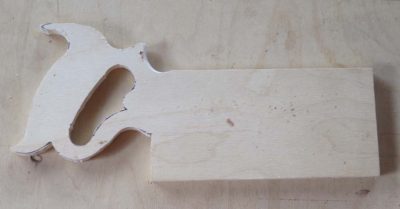Dedicated Kerfing Planes
My next step in the Great Kerfing Plane Saga was to go where I think kerfing plane evangelist Tom Fidgen started – kerfing planes with a fixed fence to produce a set width to the cut. My most typical use of resawing by hand is making hand-sawn veneers, so I decided to make my first kerfing plane part of that equation. Since I am not yet as skilled at veneer sawing as the craftsmen in the 18th century Parisian ateliers, who routinely harvested twelve sheets of veneer per inch of stock, I struck a more realistic task of cutting eight per inch. Thus, my need was for a dedicated kerfing plane set to 1/8″.

Falling back on my old habits and routine, I made the body of my plane from 13mm baltic birch plywood. I had first made a pattern for the tool, one I could use repeatedly. I derived the pattern template from a backsaw, which I traced onto 3mm plywood and cut out. The template now hangs overhead off a joist in the shop, awaiting for new kerfsaw-making urges to strike.

I traced the new kerf saw pattern on the thicker plywood, and drilled out holes where they would make the sawing the most amenable. I accomplished this with my coping saw in a couple minutes. Once I was done with the sawing I worked on the profiles of the handle with rasps and files so that it was comfortable in my hand.

I made a 3mm rectangle to be glued to the heavier plywood to provide for the cutting spacing.

The assembling continued apace with another scrap of bowsaw blade and a piece of scrap brass barstock to serve the retaining element to hold it all together.


The completed tool is a delightful amalgam of lightness with robustness for vigorous use, combined with comfort and precision for repeated cutting of veneer.

The test drive was perfect!

I followed up on this kerfing plane with one for some teaching I had upcoming, where the ultimate objective was to derive prepared oak boards of 1/4″ thickness from 5/4 stock. In this case I made the fixed cutting distance 3/8″ since this was the closest scrap I had handy, and in recognition that the folks I would be teaching had no woodworking experience and a bit extra waste would be advantageous. I will soon recount that tale, confirming the tool removed a huge potential hurdle to them completing their assignment and future task.
Thanks again Tom Fidgen for leading me down this path of simplicity for the sake of precision and efficiency.


Join the Conversation!